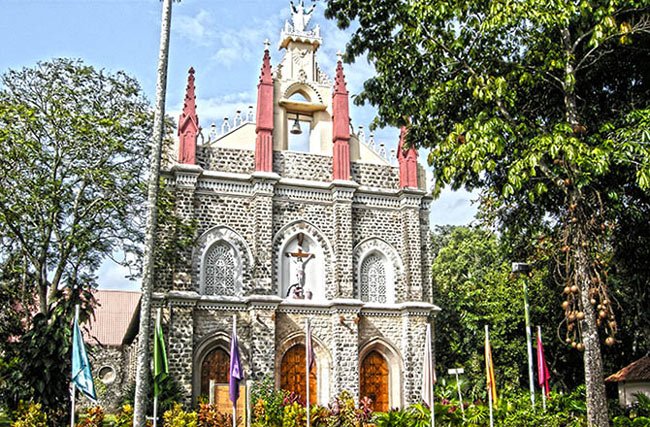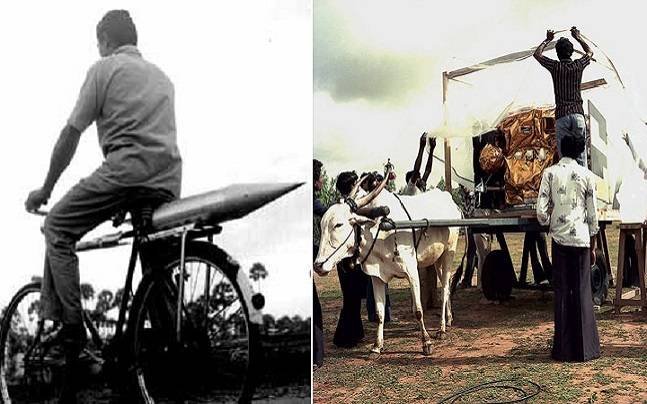Hello Steemians, here I bring to you the magnificent success story of ISRO, the Indian space agency that budded from nowhere to reach some inspiring multilayered accomplishments, each layer preceding the former. Visit to know how this organization made story of itself in space research and get some inspiration to achieve your life goals.

“10,9,8,7,6,5,4,3,2,1 and lift off and thus India becomes the first nation to send more than hundred satellites(104) into space in a single launch vehicle”. This was the news being broadcasted in the TV channels all over the world on 15th February, 2017. India surprised the world by putting 104 satellites (101 from foreign clients and 3 indigenous) into lower earth orbit with a single launch vehicle from the Satish Dhawan Space Centre at Sriharikota in the state of Andhra Pradesh, South India. The second place in this column is occupied by USSR with 33 satellites at one go. Two years back on 24th September, 2014 India had made another record by placing a Mars orbiter in the orbit of Mars, becoming the first nation to achieve it in the maiden attempt, making ISRO the fourth space agency in the world and first in Asia to reach the orbit of Mars. What is more surprising is that ISRO did it with a budget of only US $73 million which is less than the total budget of the Hollywood movie Gravity.
The readers can watch the documentary of National Geographic on India’s Mars Mission[ here]
You can also watch the launch of the record making 104 satellites[here] and moments of the separation of the satellites recorded with the camera onboard the launcher[ here]
India, land of the 5000 years old Indus Valley Civilization and home of the Vedas and Upanishads was always a leading contributor in science and mathematics. India lost its glory in the world in course of time owing to the destructions carried out by the invaders and the loots of the colonizers. On 15th August, 1947 India got independence from United Kingdom to become a fully sovereign republican nation. With the historic speech Tryst with Destiny of the first prime minister of India, Jawaharlal Nehru, which says,’ At the stroke of the midnight hour, when the world sleeps, India will awake to life and freedom…’ India became the creator of its own destiny.
Right after independence India started working on its long term ambitions to become a leading nation in the world. ISRO, which stands for the Indian Space Research Organization headquartered at Bangalore, India came into being on 15th August, 1969 supplanting the erstwhile Indian National Committee for Space Research (INCOSPAR) established on 1962. the motto of ISRO is "Space technology in the Service of humankind".With the leadership and far farsightedness of its founder Dr. Vikram Sarabhai who is known as the father of Indian space program ISRO would achieve zenith heights in future. Visit the official website of ISRO[here] to know more about its history and future goals in detail.

During its initial periods ISRO had to undergo a hard time of struggle. The foundation work for ISRO was being set before it came to existence during the INCOSPAR period. The bishop of the small church in the Thumba village near Thiruvananthapuram, Kerala’s capital gave away the church to INCOSPAR which the scientists turned into the Thumba Equatorial Rocket Launching Station (TERLS). A cattle shelter was turned into a research laboratory for carrying out the experiments for developing and processing the rockets. Due to lack of fund the rocket parts were carried(which were small experimental rockets) in bicycles and bullock carts to the launch-pad. The Nike-Apache rocket was the first rocket tested by the team at TERLS in 1963. Dr. Vikram Sarabhai and Dr. A.P.J. Abdul Kalam, who later became the 11th president of India were the early pioneers at TERLS. TERLS was later renamed as Vikram Sarabhai Space Centre in honor of Dr.Sarabhai.


ISRO built its first satellite Aryabhatta(named after the ancient Indian astronomer of the same name) and launched it from Soviet Union on 19th April, 1975. After this ISRO focused on building its own launch vehicles during 1960-1980 to become a self reliant space agency. In 1980, ISRO launched the satellite Rohini with its indigenously built launch vehicle Satellite Launch Vehicle-3(SLV-3). It also built the Augmented Satellite Launch Vehicle also known as ASLV during 1980s. The most popular and reliable launch vehicle built by ISRO is the Polar Satellite Launch Vehicle (PSLV) which is used for placing a satellite in the polar orbit. It was used in the Mars Orbiter Mission, for launching the record making 104 satellites and many other missions. The success rate of PSLV is 99%. However, the maximum carry capacity of PSLV is 2 ton. ISRO had to still rely on foreign rockets for the launch of its heavy satellites of the INSAT series. In the early 2000s it developed its first Geosynchronous Satellite Launch Vehicle (GSLV) with a cryogenic engine purchased from Russia for placing a satellite in the geostationary orbit and carried out a successful launch of an INSAT series satellite in 2004.
With a 15 year long struggle ISRO built and finally tested its indigenously built cryogenic engine in 2015 which makes ISRO capable of launching a 4-ton-heavy satellite. On 5th June, ISRO launched its heaviest rocket GSLV Mark –III which used this engine to launch the satellite GSAT-19. With this achievement ISRO is now capable of a manned mission to space. ISRO has launched numerous communication satellites and earth observation satellites till now.
Some of the Major Milestones Achieved by ISRO:
1. Lunar Mission
ISRO successfully carried out a mission to moon by launching the orbiter Chandrayan-1 on 22 October, 2008. The orbiter successfully entered the lunar orbit on 8 November, 2008. It was the first extraterrestrial mission of ISRO. This probe proved the existence of water on moon for the first time.
2. Mangalyan-1
ISRO became the first country to reach the Mars orbit in a maiden attempt on 15th February, 2017. The probe carried an orbiter named Mangalyan-1 to Mars orbit.
3. IRNSS, the Satellite Navigation System
IRNSS which stands for Indian Regional Navigation Satellite System is an Indian version of the American GPS system being developed by ISRO. India was denied access to the American navigation system during the 1999 Indo-Pak Kargil War. Hence, India developed IRNSS for the purpose of national security and domestic navigation purpose.
4. The record making 104 Satellite Launch.
5. SAARC Satellite
On 5th May, 2017 India gifted a communication satellite to the SAARC nations having 12 Ku band transponders (36MHz each) as a gift to its neighbors. It was named as the SAARC satellite.
The Future Missions of ISRO:
1. Chandrayan-2
It will be ISRO’s second mission to moon which will include an orbiter and a land rover to be carried out in 2018 to study the genesis of the moon.
2. Mangalyan-2
It will be the second mars mission of ISRO to be carried out in 2021-22.
3. Venus and Jupiter Exploration
ISRO is planning its maiden mission to Venus and Jupiter to be carried out in a few years to study the atmosphere of two planets.
4. Solar Probe
ISRO will carry out a solar mission which is named as Aditya-1 in 2019-2020. It will study the corona of the Sun in visible and near-IR band.
5. Helium-3 Mining Mission
Though it is not officially announced but it is known from some top officials at ISRO that in the next decade it is planning to mine the lunar surface for Helium-3 isotope which is abundant in lunar surface but rare on earth. It will be used to fulfill the energy needs of India.
6. Manned Space Mission
After the successful testing of the indigenously built cryogenic engine India is now capable to carry out a manned mission to space. It will cost ISRO US $1.9 billion. But the government of India has not yet approved the fund. It is expected that the mission can be carried out after the 7 years of funding.
India was highly criticized by other countries as well as from inside for the relevance of a space program being a newly independent nation and is still criticized because of the low per capita income of its people and illiteracy of a major population of it. But as said by Dr. Sarabhai,"There are some who question the relevance of space activities in a developing nation. To us, there is no ambiguity of purpose. We do not have the fantasy of competing with the economically advanced nations in the exploration of the Moon or the planets or manned space-flight. But we are convinced that if we are to play a meaningful role nationally, and in the community of nations, we must be second to none in the application of advanced technologies to the real problems of man and society"
Dr. A.P.J. Abdul Kalam had said,"Many individuals with myopic vision questioned the relevance of space activities in a newly independent nation, which was finding it difficult to feed its population. Their vision was clear if Indians were to play meaningful role in the community of nations, they must be second to none in the application of advanced technologies to their real-life problems. They had no intention of using it as a means of displaying our might"
The new records and the future missions of ISRO are ample to answer those questions. ISRO is now the most favored destination of the foreign clients for their satellite launch because of the low cost launch of ISRO. Even the American clients prefer ISRO to their domestic agency NASA for their satellite launch which is evident from the fact that out of the 104 satellite launched by ISRO in 2017, 96 were solely from US clients. Thus ISRO is now helping the Indian economy grow by earning revenues in a large scale through its satellite launch business. ISRO is now the most favored destination of the foreign clients for their satellite launch because of the low cost launch of ISRO. Even the American clients prefer ISRO to their domestic agency NASA for their satellite launch which is evident from the fact that out of the 104 satellite launched by ISRO in 2017, 96 were solely from US clients. Thus ISRO is now helping the Indian economy grow by earning revenues in a large scale through its satellite launch business. With a booming economy combined with the achievements of ISRO India is reclaiming its ancient glory as a leading nation of the world.
References:
1.Wikipedia
2.Indian Space Research Organization (ISRO)
3.Satish Dhawan Space Centre
4.Vikram Sarabhai Space Centre
5.Times of India
I hope you enjoyed learning about ISRO. If you love dreaming and learning science then please follow me, @physics-o-mania.
Don’t forget to read my previous articles:
- The Quest for the Grand Unification: The Theory of Everything
- Hunt for the Dark Matter: The Unseen Neighbor
- The Strange Face of Reality: The Quantum Realm
- Quantum Computers: A Threat to Bitcoin
- Teleportation: The Ultimate Revolution in Transportation
- Einsteinian Revolution
If you are interested in various domains of science and mathematics then join the @steemstem project, team to support high quality STEM(Science,Technology, Engineering and Mathematics) related contents. Join them in steemit.chat to interact with the science authors from all over the world.
Thank you for reading my content!!
